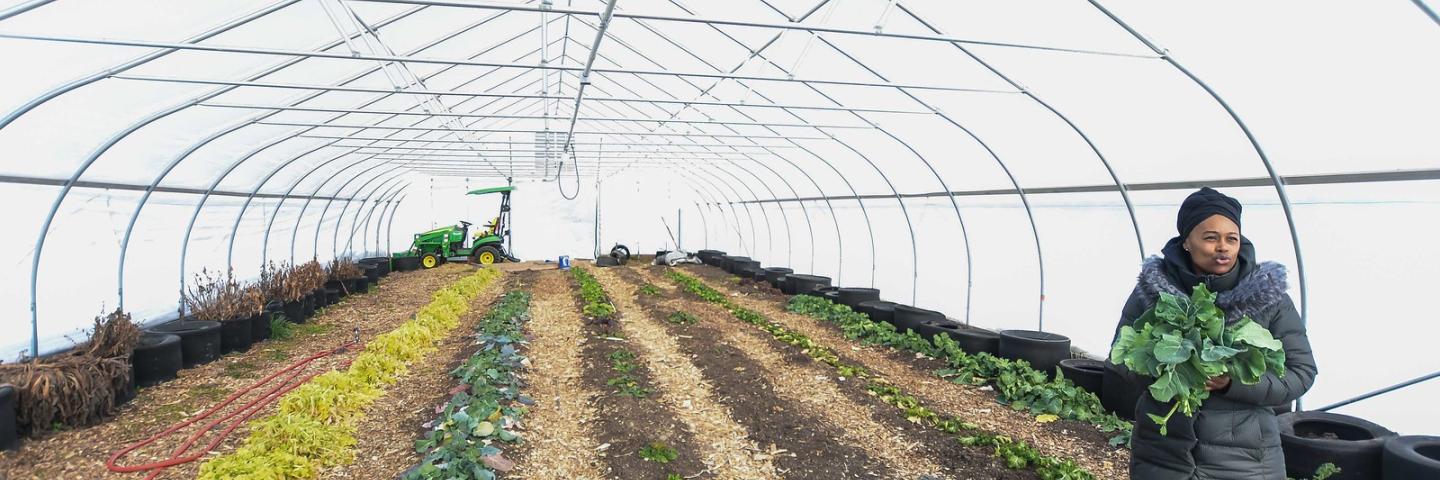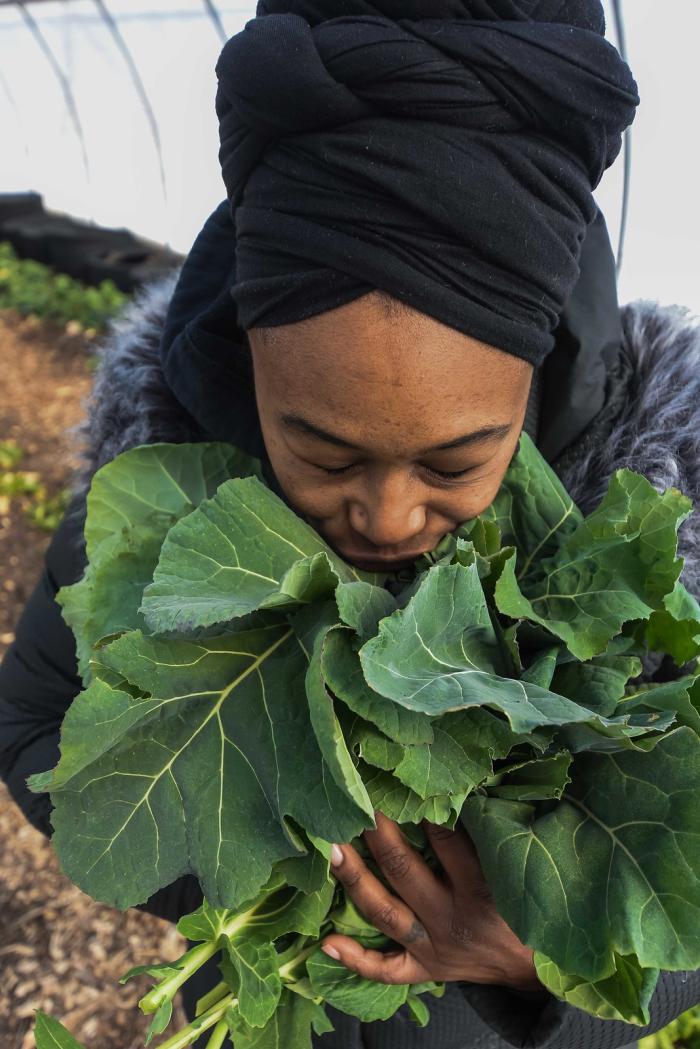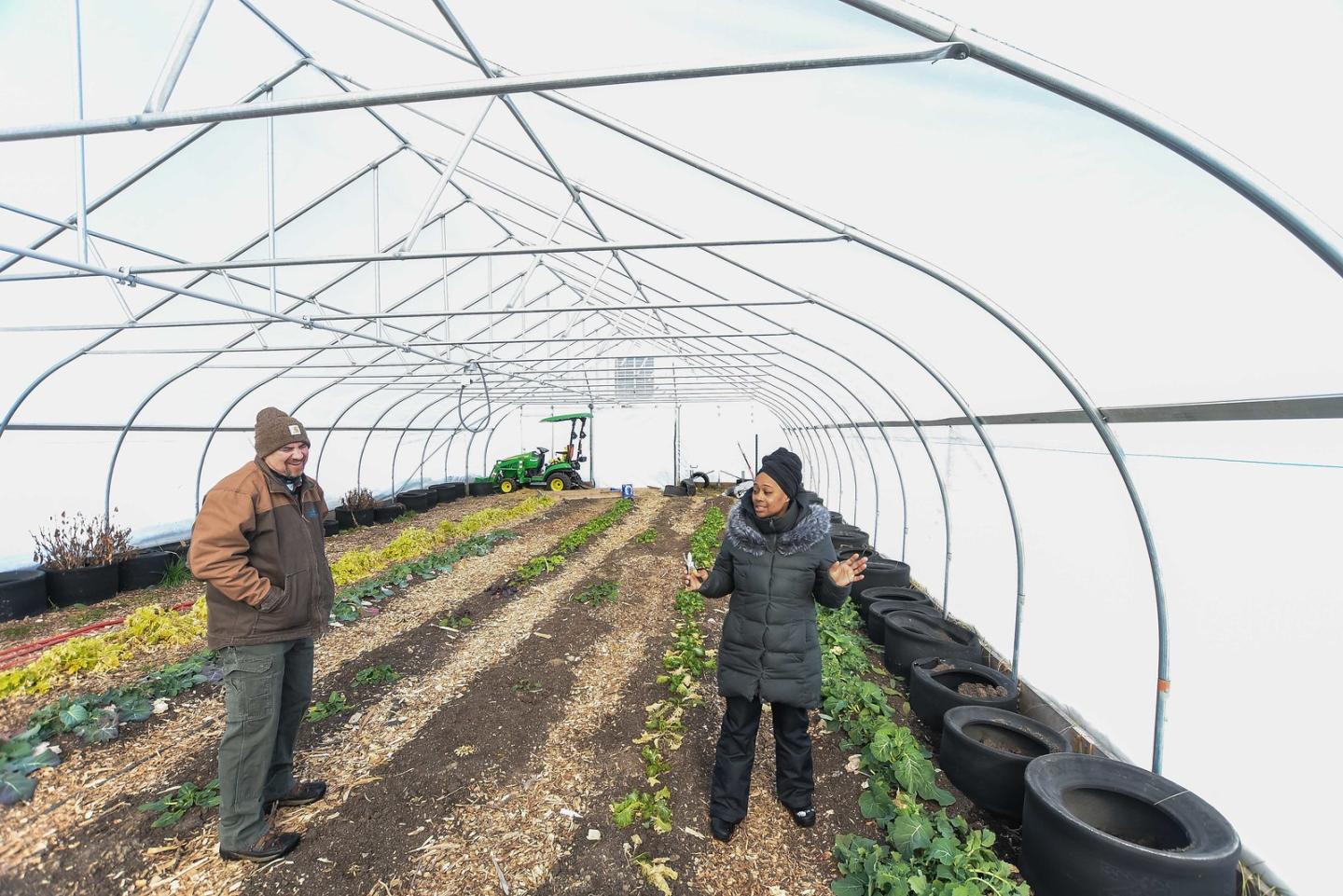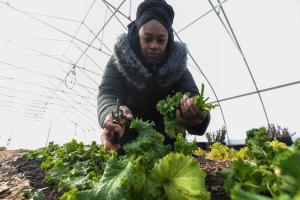Indiana Community Garden Flourishes, Makes Impact in Food Desert

Sharrona Moore started Lawrence Community Gardens to provide fresh food to her community after a health scare caused by her own eating habits.
By Brandon O'Connor, Public Affairs Specialist, USDA-NRCS, Indianapolis
To understand Sharrona Moore’s story and why she has spent the last four years turning seven acres of unused land behind a beverage distribution warehouse into an urban farm, you first have to get to know her neighborhood and the lives of those who call it home.
So, close your eyes and visualize yourself as a mother with two young children at home. It is snowing outside; you have no car and you need to go to the grocery store. In Moore’s neighborhood, which is located just outside of Indianapolis, Indiana, that is no small feat. There is no store within walking distance and none of the closest grocery stores are located on a direct bus route. But you and your family need food, so, you brave the weather and walk two blocks to the closest bus stop. Then, you take two different buses to get to the grocery store, where you find yourself with tough decisions to make.

You are limited to what you can carry, so maybe you can get three or four bags of food that won’t spoil and can feed your family for a little while. It is unclear when you will be able to come back, so most fresh produce is not an option. The balance between how much you can carry and how often you can return forces you to shop in the interior aisles where the canned foods are kept. Efficiency, cost and shelf-life outweigh factors such as nutritional value.
Moore has lived that life and watched the negative impact it had on her and the people of her community. The poor food options lead to medical issues. The children go to school after grabbing junk food from the gas station for breakfast and then crash from a sugar high in the middle of the day. As she looked around her community and her own life, Moore could trace many of the issues she saw back to food and the choices they were forced to make due to difficulty of access. So, in 2016 she set out to give her community access to the healthy, fresh food they so desperately needed.
“It's just a snowball effect on the community. The community as a whole is majority black and brown. The medium income is below normal standards. These people don't have access to transportation,” Moore said. “So, the canned goods, high in sodium, increase your blood pressure, and also increase your chances of getting diabetes. Then we have a lot of social disorders in the community. A lot of those are impacted by not having balanced meals on a day-to-day basis.”
Moore had always grown food. When she was growing up, members of her family had a farm north of Indianapolis where they raised pigs and chickens and grew vegetables. The farm fed her family and over the years she developed a love for growing food and playing in the dirt that she’s carried with her all her life. As an adult, she was constantly growing at least some fresh vegetables, but when her brother was diagnosed with Crohn’s disease and the dietary restrictions that come with it, she decided to learn how to grow more and better food to support him and her family.
Her first step was to enroll in an urban agriculture certificate program through Purdue University. While taking the class her initial desire to help her family blossomed into a plan to impact her entire community. In late 2016, she approached a local beverage distributor she lived near that had a large, unused plot of land and asked if she could turn it into a garden. They offered to rent her the land for $1 a year and she has spent the last four years transforming it from an empty lot of nothing but grass into a flourishing urban farm that provides food to her entire community.
“I can't tell you how it happened,” Moore said. “It was never supposed to be this. I didn't know what it was going to be. I just wanted to start something. God told me to do this. I'm a barber. I cut hair, but once I decided I was going to do it, opportunities just opened up and it started making a difference for people.”
During that original class at Purdue, Moore heard about the USDA’s Natural Resources Conservation Service and quickly reached out. She applied for the agency’s Environmental Quality Incentives Program (EQIP) and was able to receive priority access to the program as a socially disadvantaged, low resource and beginning farmer. The EQIP funding she received for the farm funded most of the purchase price for a high tunnel, which was installed in 2018, and the upcoming planting of a hedgerow to provide a pollinator habitat and access to edible perennial fruits and berries.

“This (high tunnel) was way more than what I would be able to afford,” Moore said. “I mean, I would save maybe five to seven years and I wouldn't be able to afford a hoop house of this size ... The NRCS' help with bringing a hoop house here to our neighborhood is allowing us to improve food access for one of America's largest food deserts.”
When Moore started the farm, her plan was to help provide healthy food to her community in order to cut down on health issues. Right from the beginning she realized through her own experience just how important a mission that was.
She broke ground on what is now known as Lawrence Community Gardens in early 2017 and then on April 13 of that year, she suffered a heart attack at only 43. She had started making lifestyle changes, but here was a definitive message from her body that she had waited too long and needed to make even more substantial changes.
“I had to suffer a health crisis and then the garden became less of a project and more of a passion,” Moore said. “I started growing food for people who are suffering from diet related illnesses and I began to learn how nutrient dense food cannot just sustain your body, but it can heal you.”
She calls it “vegication” and has worked to teach her community and those who work at the farm the power of healthy food and the impact it can have on your overall health. A key part of that has been reaching out to the youth in the community and teaching them from a young age the impact of making good food choices, while also showing them how to grow food themselves.

From the beginning Lawrence Community Gardens was a family operation and as Moore watched her children take ownership of the farm and learn the ins and outs of the operation, she realized there was an opportunity to have a much larger impact than just providing healthy food to her neighbors. Over the last couple years, she has used the farm to have a generational impact on her community by transforming into an almost entirely youth led operation. Students as young as 12 can come and farm, learn about healthy food and then take fresh food and the lessons they learned back home to share with their families.
“Gardening is revolutionary because there's something magnificent about bringing a seed to harvest and then being able to replicate that again and again and again with the same plant,” Moore said. “We are creating a new generation of young people who are aware of their power. You are superheroes if you can grow food. That's the superhero act and that's how we treat it.”
Moore has also worked to address the food access issues in her community through every decision they have made at the farm. The foods they grow, such as collard and mustard greens, tomatoes, peppers and okra, are ones she knows the members of her community will eat. They have also opened a mobile farm stand that goes directly to people’s houses, nursing homes and schools so people who don’t have transportation can purchase healthy food. On the mobile farm stand Moore is able to accept two federal food assistance programs and she also brings along recipes to help people learn more about preparing items they may not have had access to in the past.
After four growing seasons on the farm, Moore can already see the impact it is having on her community. They started with 18 students working on the farm the first year; she had more than 30 come and work during the last growing season. The mobile farm stand has become such a fixture in the community that when she arrives at the senior center the residents are sitting there waiting and get mad if she’s even a few minutes late.
The high tunnel has played a key role in the success of the community gardens because they are able to grow food almost year-round. The neighborhood’s food security issues don’t suddenly disappear in the winter and even with a couple inches of snow on the ground in early February the high tunnel is still brimming with life and providing fresh greens to her community.
“It's Feb. 2 and I'm harvesting greens in my hoop house,” Moore said during a recent visit to the farm. “That's a huge win for the neighborhood. Traditionally, here in Indiana the growing season is only about 26 weeks. This hoop house is allowing us to grow 365 days a year. We have access to fresh, nutrient dense food every day of the year because of this hoop house.”
Additional Information
Small/Urban Farming - Indiana
NRCS serves all agriculture – large to small, conventional to organic, rural to urban. As American agriculture continues to grow in new directions, NRCS conservation assistance is growing along with it.
Learn MoreEnvironmental Quality Incentives Program - Indiana
The Environmental Quality Incentives Program (EQIP) provides financial and technical assistance to agricultural producers and non-industrial forest managers to conserve natural resources while strengthening their operations.
Learn MoreHISTORICALLY UNDERSERVED PRODUCERS
Historically Underserved producers may be eligible for the advance payment option as well as targeted funding pools and priority consideration when applying for assistance.
INDIANA NRCS HOMEPAGE
For more information about NRCS programs offered in Indiana and how experts throughout the state can help you address natural resource concerns on your land, visit the Indiana NRCS homepage.


